NeuroTrac® Simplex

- Suitable for diagnosing, monitoring and treating a wide range of muscle problems
- Single Channel EMG unit
- Optional multilingual computer database system
- Structured protocols for consistency of patient progress reports (software)
- Used as a EMG biofeedback training aid or diagnostic tool
- Measures EMG from 0.2µV to 2000µV Accurately
- Designed for a wide range of physiotherapy applications such as incontinence, shoulder and neck pains, patello femoral pain, repetitive strain injury, stroke plus much more
- Used as a learning tool for both patients and therapists with emphasis on improving rehabilitation techniques
- Produces and prints comprehensive patient progress reports of work/rest averages, onset contraction and muscle release times, peak values, work/rest average deviations (with optional software)
- Ability to lock the unit
- Records EMG statistics
- User friendly
- Compact, light and reliable
- Easy to use optional software available
- Low cost high quality and very accurate
• EMG Work/Rest Assessment
• Example of Work / Rest assessment (Using the NeuroTrac PC Software):
• Work / Rest assessment report
• Statistics
What is EMG Biofeedback
Electromyography (EMG) or Biofeedback is a technique for evaluating and recording the electrical activity produced by skeletal muscles. EMG is performed using an instrument called an electromyograph, to produce a record called an electromyogram. An electromyograph detects the electrical potential generated by muscle cells when these cells are electrically or neurologically activated. The signals can be analyzed to detect medical abnormalities, activation level, recruitment order or to analyze the biomechanics of human or animal movement.
1. Using the NeuroTrac™ device, find the muscle and place a pair of skin electrodes on the main bulk of the selected muscle, with the separation of 1-5 cm between the electrodes.
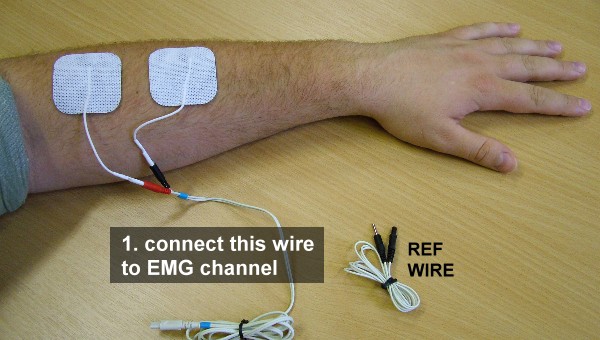
2. Always remember to Use the reference Wire! Place the reference Electrode anywhere on the body, this will provide the accuracy to the measurement.
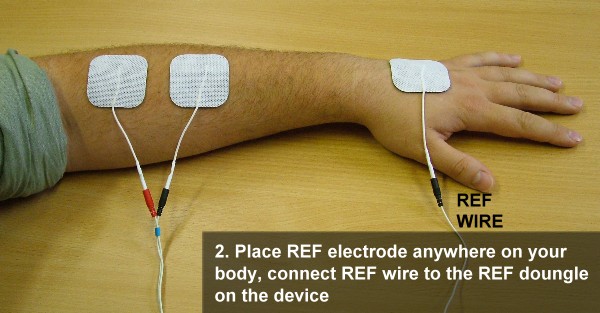
3. After you place the REF and measuring pair of electrodes, connect them to the unit. Your level of relaxation/contraction, measured in microvolts, is displayed. When there is no interference and a proper connection, a reading below 4 microvolts is considered as a relaxed muscle indicator.
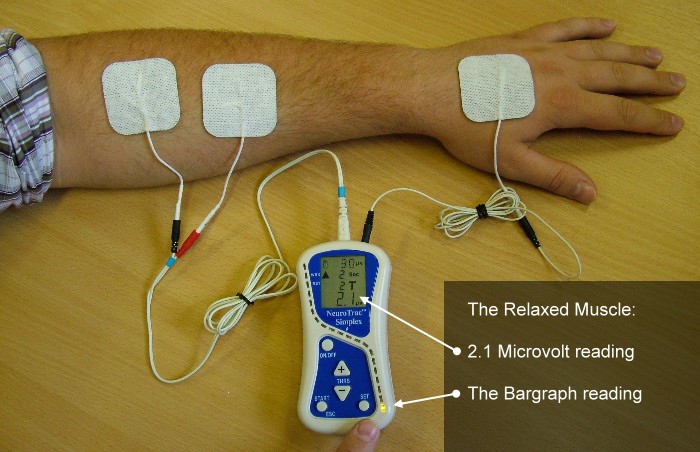
4. When you contract your muscle, you can observe that the bargraph reading goes up with the contraction. If you cannot light the top LEDs on the bargraph, you can re-scale the bargraph to be more sensitive, by decreasing the threshold (THRS button).

5. You can use the optional PC Software with the Simplex: you will see your EMG biofeedback reading ont he PC as a running graph.

EMG Work/Rest Assessment
The NeuroTrac™ Simplex allows you to complete the Biofeedback Work / Rest assessment. This is an example of what your own might look like:

When you run the Simplex programme, the Patient is prompted to contract the muscles as fast as possible and keep them contracted over the threshold level, during the Work segment of time (5 seconds). After the Work segment, there is a Rest segment (5 seconds), where the Patient is prompted to relax the muscle as fast as possible and keep relaxed significantly below the threshold, over the Rest period of time. A good level of relaxation is below 4 uV. An excellent level is below 1 uV (make sure your device does not have too high or unstable a reading due to magnetic interference - read the manual thoroughly to help understand how to reduce magnetic interference as much as possible).
Once the Work / Rest assesment is finished, the statistics are displayed on the LCD display. The comparative analisys of the statistics collelcted from previous assessments gives you the key to understand the progress of muscle rehabilitation. The statistics are explained in the Manual.
Example of Work / Rest assessment (Using the NeuroTrac PC Software):
When your NeuroTrac Simplex is connected to the optional NeuroTarc Software, The Software generates visual prompts on the screen:
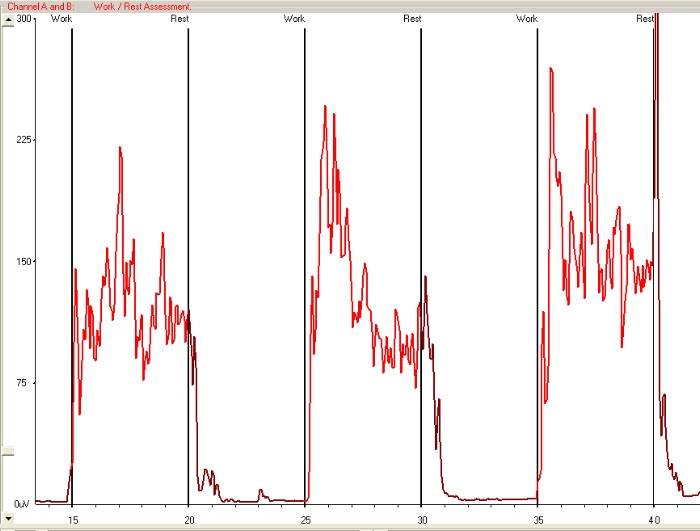
Work / Rest assessment report
The assessment record is stored in the Software. The Report of the Work / Rest assessments could be generated, where you can compare the graphs to be able to identify the progress trends:
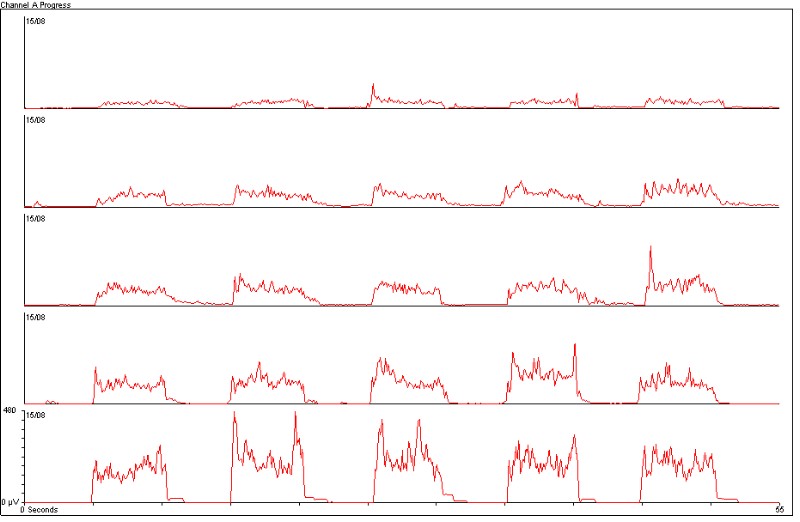
Statistics
When you do one trial (one repetition of Work / Rest), the unit measures the following statistics:
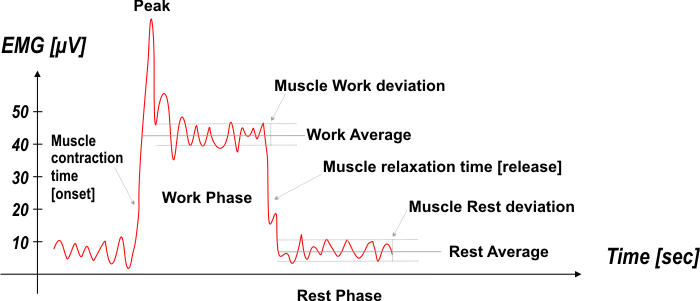
Work Average [µV] - the overall average microvolts achieved during all the work periods of the session. Generally the higher the Work average is, the better the muscle performance.
Rest Average [µV] - the overall average microvolts during all rest periods of the session.
Generally the lower the Rest average is, the better the muscle performance. It is very important how low you can relax your muscles in terms of microvolts.
Below 4µV a muscle is beginning to rest. If the Rest average is above 4µV make sure you use the EMG reference lead wire! A reading above 4µV commonly means the muscle is overstimulated or tired after a long EMG training session.
Onset Average [sec] - This is the average time taken in seconds to achieve 75% of the work average of all work segments, any values over 2 seconds are ignored.
Generally this parameter measures how fast you can contract a muscle, the shorter the Onset average time is, the better the muscle performance. Readings below 1 second can be considered normal. The time it takes to contract a muscle gives an indication on the recruitment of the fast twitch fibres. If the onset time was slow, the recruitment percentage of the fast twitch fibres would be less than if the onset time was faster.
Release Average [sec] - This is the average time taken in seconds to relax below 37.5% of the work average of all work segments, any values over 2 seconds are ignored.
Generally this parameter measures how fast you can relax a muscle, the shorter the Release average time is, the better the muscle performance.
Healthy muscle normally reverts back to a low resting EMG value in less than one second. If the muscle takes longer to revert back to rest then there will be a reason, such as muscle or nerve damage or some other underlying problem.
You can power on this easy to use Biofeedback unit and the real time EMG will be continuously measured. You can press the START button to begin the Work/Rest programme. Here you will be prompted to contract and relax muscles. When the session is finnished, the statistics will be displayed on the LCD: work time, rest time, onset and release time. One easy to use customizable programme, where you can use the default settings or change: work time, rest time, number of repetitions, etc.
Please read the Quick Start instruction which explains how to operate the unit, the basic functionality and troubleshooting:
NeuroTrac Simplex - Quick Start and Troubleshooting (English)
| Protocols | Author | Download |
|---|---|---|
| Treatment of the Hemiplegic Shoulder (Stroke) through Biofeedback: Case Study | Verónica Bargueño, Juan Nicolás Cuenca & Eric Lazar | |
| Urinary Incontinence | Julia Herbert Grad. Dip. Phys. MCSP SRP Specialist Continence Physiotherapist | |
| Pelvic Floor Muscle Activity in Sitting & Standing Postures | R Saphod, C Maher and C Richardson | |
| Incontinence Case Reports | Pirkko Ravio Specialist Continence Physiotherapist | |
| Patellofemoral Pain | James Selfe. PhD. MA. GD Phys. MCSP. SRP. Lecturer Chartered Physiotherapist. | |
| Prolapse: Pelvic Floor Muscle Training for Women | Karen Radford, MSc, MCSP and Funmi Odofin, BSc, PG Cert. MCSP |
- The package includes PC Software. Up to 10 m of wireless connection (Bluetooth).
- Single Channel Digital EMG Unit.
- Accurate Range: 0.2µV to 2000µV.
- Sensitivity: 0.1µV RMS.
- LEDs display EMG level clearly and easily.
- LCD displays numerical EMG reading and work/rest countdown.
- Selectable band pass filter to filter out heart rate.
- Work / Rest periods: 2 to 99 seconds.
- Number of trials: 1 to 99.
- User friendly.

 devices
devices

















